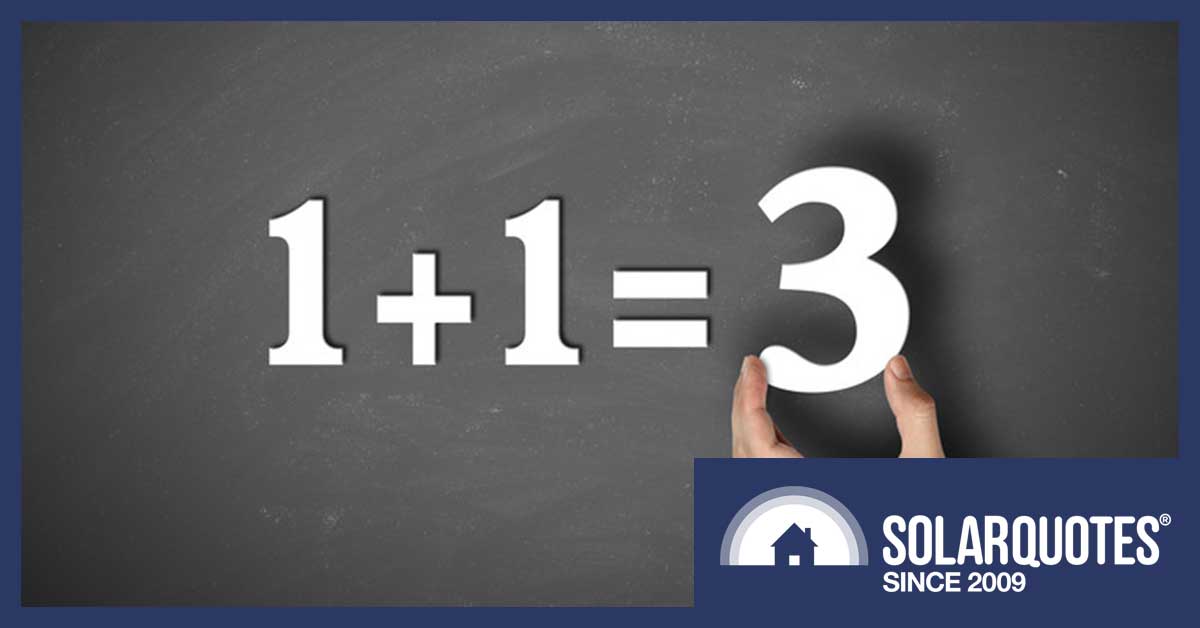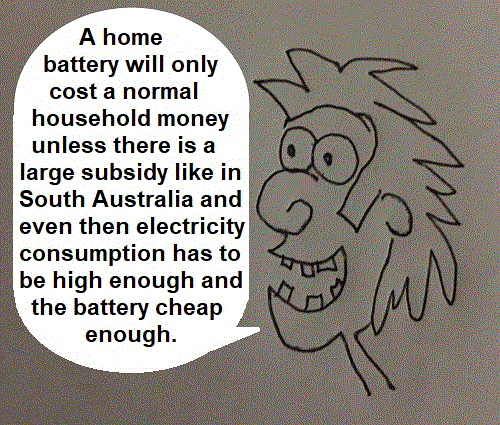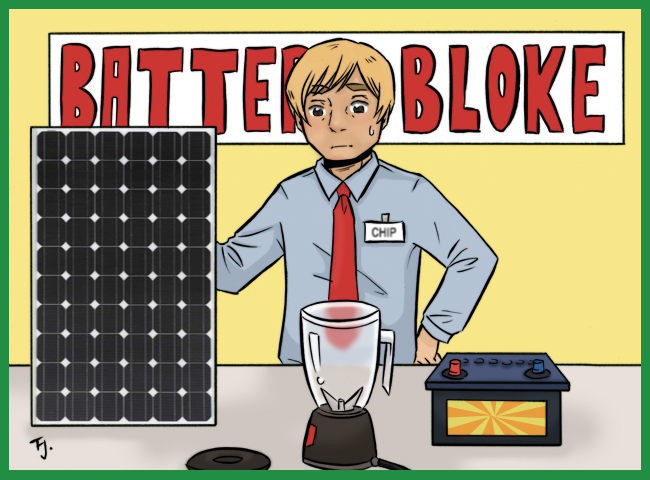On Thursday the 1st of May the Smart Energy Council put out a press release1that strongly implied home batteries can pay for themselves. Unfortunately, at this time, they don’t with the possible exception of South Australia with their hefty subsidy of up to $6,000. Anyone who says they do without a large subsidy is either being ignorant, incompetent, or deceptive.
I don’t know why the Smart Energy Council is so clearly failing to live up to its name. The harm that can come from the misleading information they’re spreading includes:
- Inflicting real financial hardship on Australian families when the battery system they buy ends up costing them money instead of providing savings, and…
- Enabling con artists who will now find it easier to convince people to buy solar battery systems that only make the seller money and only lose the buyer money.
It makes me wonder if they are evil:
Or stupid:
Or both:

Image: The Independent
A Misleading Headline
The problem with the Smart Energy Council’s press release begins with its headline:
If an average person who’s not particularly knowledgeable about solar batteries read that, you’d think it would be quite reasonable for them to conclude:
You certainly wouldn’t expect them to conclude the following:
This is unfortunate because it is the second speech bubble that is correct.
Blended Payback Hides Cost Of Solar Batteries
Assuming you trust me when I say home batteries won’t pay for themselves without a large subsidy like in South Australia, you may be wondering why the Smart Energy Council says they do. But this is where the deceptive trick lies. They don’t actually say buying a home battery will save you money. They say buying solar and a battery will save you money. This is sort of true in the sense that you’d be $80 ahead if I gave you five $20 notes and you flushed one down the toilet. Sure, technically you’re ahead, but you’re still an idiot for flushing away $20.
Rooftop solar power can pay for itself fast but batteries can’t, so the Smart Energy Council has combined the payback of solar and batteries together to hide the fact that batteries are normally a money-losing proposition. Squishing them together like this is called blended payback and I wrote about it here.
The Smart Energy Council don’t explain how they arrived at their blended payback figures, but I’m willing to bet they used very optimistic figures for the battery side of things. They do state they spoke to battery manufacturers, but that’s like asking a shark if you’d look better with one arm and one leg less. You’re not likely to get an unbiased answer.
If you’re interested in how difficult it can be for a battery system to pay for itself in South Australia even with the highest battery subsidy and highest grid electricity prices, you can read about it here.
And if you want to see how much batteries cost before installation, then every solar battery system we know is available in Australia and have information on is in our solar battery comparison table.
In addition to implying that batteries can pay for themselves the Smart Energy Council claims they reduce greenhouse gas emissions. While solar batteries can potentially reduce emissions2, at the moment they generally do not. They increase emissions and you can read about this problem here.
Australians Deserve Better
My tolerance for bullshit has been completely depleted by election shenanigans and the fact that for some reason the My Little Ponies have suddenly become hideous, mutated, humanoid freaks:
So I don’t appreciate the Smart Energy Council putting out a press release that could result in ordinary Australians suffering real financial harm. We deserve better than this from industry bodies.






 RSS - Posts
RSS - Posts



What did they say when you contacted them to check their reasoning ?
I have written to them giving them the link to this page and asking them that if the information on here is correct, why they appear to be deliberately misleading consumers about batteries.
If I get a response I will post it back here.
Thank you for that, Adam.
I didn’t contact them. They put out a press release strongly implying that home batteries would pay for themselves so I quickly put up a piece to let people who are looking into it know this is not the case with the potential exception of South Australia. Unfortunately, misleading information can be halfway around the world before rebuttal has got out of bed.
If they want to send me their reasoning I can go over it and pick it apart, but that would take time. And I don’t think they would have anything that would surprise me, at least not in a nice way. The only thing I am wondering about is if they included payments from virtual power plants which, except for some trials, people can’t actually join yet.
OMG – I had no idea My Little Ponies have suddenly become hideous, mutated, humanoid freaks.
Thanks for heads up Ronald.
Love your work
Thanks again for your efforts to reduce ignorance, Ronald. There just isn’t enough publicised about this ‘new’ technology.
Friends (early 80s) mentioned recently that they were considering buying into a battery system when their / WA’s 47c FiT expires on their 1.8kW solar panels.* Naturally, I attempted to persuade them that they’d be far better off increasing the number of panels on their roof.
I’m not sure that battery sellers would dissuade them from buying a battery system. Nor am I sure that my counter-proposal convinced them of the two very good reasons why panels were a far better solution. In the very green community in which we live, solar batteries have ‘green-status-cred'(!)
* I actually did succeed in talking them into that 1.8kW system ten years ago. It cost < $1800 installed. They've paid _nothing_ for power for a decade… and most years they've received FiT cheques for $1200 – $1600 annually!~
Well I have a 7.8 k/W solar system with a battery and I pay no power bill (including the power and wires charge).
The Energy Councils press release looked realistic enough for me.
I’ve calculated the payback period for my system to be around 9.5 years but this will vary according to future electricity prices, government policy, geographic location etc etc.
The key has been to find the very best power company deal preferably wholesale rates for off peak, shoulder and peak and get the best feed in tarriff possible.
In terms of batteries there will always be a higher cost for early adopters. The price will fall quickly with economies of scale (if people would just support renewables) and advances in battery technology.
Sweeping generalisations don’t help.
Tony – I think you missed Ron’s point. Yes a battery can help you pay less/zero for your electrical bill. But not so much less that you would actually pay for your battery within the warranty period compared to solar alone.
3 factors at play.
1. Opportunity cost. You could have invested the money you spent on a battery in the stock market and earned money.
2. Less FiT – the amount you might have got back on your electricity bill is less because excess solar is being used to charge the battery and not return to the grid. Because of the inherent round trip losses in a battery system this is also where they fail the green test.
3. The capital cost of the battery has to be amortised over the lifetime of the battery.
No one is saying you shouldn’t buy a battery and people’s reasons vary, just that as it stands, with the price per kWh for retail systems, they do not pay for themselves.
Fair enough. Although the stock market may not result in a profit… but I see your point.
All the same battery prices will reduce with more adopters.
I have a feeling that home ESS systems may never really make it into the mainstream electricity world as I have a feeling the software and hardware developments in the few years will see distributed ESS a better option – use what you can when you can from you solar system, send surplus solar of to the distributed ESS and get it back when required for the house or EV; or variations to such a scenario.
AI, block-chain and other technologies might make this par for the course in the not too distant future. Community VPP rather than retailer controlled systems.
Hi Ronald,
I was thinking the same as you, but I had another look at the battery table and there do look to be some systems on there that actually could save a typical household money after the subsidy now.
For example, the SolaX Triple Power 6.3 is listed as costing $4,000 excluding installation for a 6.3kwh battery. After the SA subsidy of $500 per kWh that would be $1000 or $2000 after a $2000 federal labor subsidy. It is also small enough that a typical household would usually full cycle it each night or close to it.
Now, that one is only compatible with a SolaX inverter, but if you are installing a new solar system with the battery then you can choose that inverter if you like and getting it done at the same time should meant that installation is cheaper and fairly straightforward.
It still isn’t going to save a lot of money, unless feed-in tariffs decrease without a corresponding decrease in usage charges in the future or if significant revenue from a VPP becomes available, but at that price it should at least save money after the subsidy.
I still agree that the Smart Energy Council press release was crap, and there is significant danger of people losing money buying more expensive batteries, but at least it looks possible to save money for a typical household which is an improvement from where it was previously.
I think there could be a real potential for a battery to be used to be able to get more panels usefully on a roof that would otherwise be possible and make financial sense that way, especially for single-phase systems that are limited to 5kw export in a lot of places (e.g. to have a useful 10kw of panels with a 5kw inverter or export-limited inverter), but there are so many pieces that need to work togeather to make it happen that I’m not sure we’ll see that any time soon (cheap-enough batteries with a compatible inverter that can handle enough panels while still being allowed to be installed on a single-phase supply and a system that is smart enough to charge them in the middle of the day when the system is export-limited rather than first-thing in the morning so they are full by the time the system becomes export-limited, ideally being smart enough to know about the weather and time of year and start charging earlier if it needs to).
Agree …but I think your statement that single phase systems are limited to 5 k/W is not correct.
https://support.solarquotes.com.au/hc/en-us/articles/115001272534-I-ve-been-told-my-maximum-solar-system-size-is-5kW-Is-that-correct-
That’s a 5kw export limit, not inverter limit or panel limit. A very common setup is. 5kw inverter with 6.66kw of panels. There are limited options to go higher than that due to rules and available inverter specs, but it is possible to install 10kw of panels with a Fronius 8.2kw inverter and a Fronius smart meter set up together to export limit to 5kw for example.
Which stock market Mondo? the Aussie one that has gone nowhere for a decade…surely not, as that scam is bigger that the central bank money printing scam….so where best is your money put when you have a roof top full of panels already?
The ASX on 6 May 2009 was at 3840. On 6 May 2019 it’s 6370. That’s a compound growth average of 5.2% per year.
Alex, and that ignores dividends.
However, the savings in energy might be attractive in that they wouldn’t be taxed – whereas you will lose a portion of your dividend income to taxation.
Yep.
Unless and until the installed cost of batteries gets down to ~$250/kWh, then the majority of solar PV owners in Australia will be financially worse off investing in a battery compared with other sensible uses of the money. That may be a financial investment, paying off a debt or improving energy efficiency such as insulation, or indeed increasing the size of their solar PV system (if feasible).
Of course the price at which battery economics makes financial sense varies by individual household and so there will be some for whom it will make sense at a higher price, but I’m talking about the price at which it becomes downright sensible for the majority considering the gap between import and export tariffs, battery warranty and actual real life capacity utilisation (including various battery lifetime specs).
Currently we are at ~$1,000/kWh or higher, so there is a long way to go.
See my note below and elsewhere, Alex.
Deep-cycle lead-acid (probably AGM) batteries will store a kWh for $150 (or less if you can get a deal). Decent ones will carry a warranty of three years ~ and properly looked after will last about five years.
Easy to self-install/maintain, if one of them fails you DON’T NEED TO REPLACE the whole shebang at umpty-nine bucks.
In Victoria, when the battery rebate kicks in for 10,000 home owners, it will go down to $500-$600 per kWh. Getting closer to that target of yours:)
…and cherry-picking dates can be quite fallacious. Just prior to our ‘lite’ GFC, the ASX200 sat at 6800+. Had you bought in then, you’d have lost megabucks if you then had to sell at the low, 3200+. Note that you’d still ‘be behind’ a decade later.*
Storage _will_ like all technologies, fall in price dramatically. At the moment, in WA, with miserly FiT, batteries make little sense. Even some community systems are questionable. One example which surprised me recently is described in RACWA’s ‘Horizon’ magazine (April/May 2019, p 26 – 28).
To become a_member_ of this project, participants must pay $3.30 per day… and then negotiate a per unit rate. Now that _might_ actually work for some families; but with neither solar nor batteries on the two houses on our semi-rural block, we currently pay $3.80 per day total(!)
* We sold at 6200 and bought back in at 3250. More ass-than-class. My point is that markets fluctuate… and buy-in dates can erode investments dramatically, including Super.
um……. anyone who can’t make about 40% pa from the Australian stockmarket without even getting out of bed shouldn’t be allowed near a light-switch without adult supervision. (and they’re probably the same ones who blab their business to the Taxman!)
The Australian stock market averages a little over 8% real return.
Good article about batteries not being able to pay for themselves. I am the sales manager for a Melbourne based solar company. I am religious about warning our customers looking at batteries that they cannot pay for themselves.
I will always say that the only decent reason to get a battery is if you live in an area constantly plagued with blackouts, otherwise you’d have to put yourself into the category of an early adopter, or someone who just loves technology. For the money spent on a battery, you are far better off simply getting a bigger better solar system.
By the way, the only thing that spoils your article, is why do you feel the need to jump on to the political bandwagon of dissing Donald Trump? He is neither stupid or evil. Now Hillary Clinton on the other hand….?
I’m in an area plagued by blackouts (20+ per year). I will be installing a cut over switch and a generator. Portable UPS unit for key devices which require it (e.g. NBN box and router).
That’s a more financially prudent solution than a battery.
Considering the difference in payback between panels and batteries on a stand-alone basis… I think you are flushing more like 3 or 4 of those twenties…
Parity is coming.
I did an analysis on my system over 10 years:
No solar – going to cost me $24.1k (elec only)
6kW Solar only – going to cost me $15.6k (solar and elec)
6kW Solar and 10.8kWh storage – going to cost me $16.6k (solar, storage and a bit of elec)
For 10 bucks a month extra I get back-up, price increase insurance and helping the planet. Solar is a different product to energy storage as solar can’t do what storage can ie work at night or when the grid is down. Therefore they are 2 different products that shouldn’t be compared.
I don’t see what’s wrong with “blended” payback. If i’m going to invest in a total solar and battery storage system, then i take the total cost of the whole system into consideration. I’ve done the numbers and can make a positive financial case for having solar plus battery storage. However, it is not viable(yet) for households that don’t consume a lot of electricity. Let’s look at the numbers from the battery side of things using say an LG Chem 9.8 battery with usable electricity of 8.8 kwh. The performance warranty states a minimum of 24.3Mwh energy throughput in 10 years but only a 60% retention of nominal energy(not that great). They also claim 60% SOH after >6,000 cycles @ 90% DOD(6000 cycles is around 16 years). The energy throughput figure is around 75% of total potential energy that can be generated in 10 years.
If a household was saving say 25 cents per kilowatt hour x 24,300 kWh that would be $6,075 in that 10 year period. The cost to install an LG Chem 9.8 vary but should be around the 12k* mark. After a 6k rebate, households are neutral after 10 years( not great,but i don’t think this will lead to financial ruin and hardship). So what are the other benefits?
1. Energy Security and Independence
2. Blackout protection-run your household when the grid is down
If these things are important to you then do it because when the rebates get cut you will be sorry you missed out.
*prices will vary depending on a companies buying power(cost price of equipment), their sales commission structures and the margin they choose to work with. I’ve seen these at prices ranging from 12k-16k so do your homework. Don’t worry too much about all the fluffy stuff “look at us, were the best company blah blah blah because they are going to want the high price ie 16k. I think a thousand of these “feel good” companies have already disappeared so don’t get sucked in. The solar companies will be long gone but the major manufacturers will most likely be around to honour warranties.
Choose a decent outfit and look for a “fair” deal and you can’t go wrong.
So here we have a scenario where the battery on it’s own is neutral cost after 10 years but when you take into consideration the solar generation we have a “blended” payback period that is “in the money”.
Let’s look at the above example and calculate what the numbers are including a 6.6kw solar power system.
The cost of a decent system say Seraphim panels(tier 1) and SMA inverter would be average $6,500(if you disagree see above comments about “fluff fluff” companies)
Total generation = 5.6(Ave. sun hour days SA) x 6.6(kw) x 365 = 13,490kwh.
Lets say 90% efficiency ie 12,141 kwh per annum(33.2/day)
33.2kwh less 8.8kwh(battery)= 24.4kwh left over.
Lets say 50% own use and 50% fed into grid ie 12.2kwh own use and 12.2kwh grid.
Assume FIT 9.9 cents and electricity cost 25 cents ( by the way i’m paying 31 cents peak and others are paying more)
Own use 12.2kwh x 25c = $3.05, FIT 12.2kwh x $1.21, 8.8kwh(battery) x 25 c = $2.20, total $6.46/day. Per annum savings $6.46 x 365 = $2,358
Investment: Battery 12k minus 6k rebate = 6k plus 6.5k solar system = 12.5k
Divide $2.358k into 12.5k = 5.3 years payback(lets say 6 years)
In conclusion, your energy system is not complete without having the ability to store and consume at times that are cost effective and at times when the grid is down. Energy security for most households is attainable and it wont break the bank.
Thanks
P.S the numbers will vary according to each households consumption habits and you can use the same formula to work out your own situation:)
What’s wrong with a blended payback is when it is presented in such a way as to imply that the battery is saving money. It isn’t if buying the same system with the battery removed would save more and that’s usually the case. If the payback on both options is clearly presented then there’s nothing at all wrong with using a blended payback.
Any by all means buy a battery if you want one. And blackout protection is great, but that doesn’t always come with every battery and matters a lot less to some people than others. My own figures give a maximum savings from adding a battery (of any size) of about $300 per year and based on that there is no battery that will save me money even with a generous subsidy. blackouts only affect us probably less than once a year, so I judge it not worthwhile.
over and over and over again. GO STAND ALONE. A battery bank of quality DEEP-CYCLE AGM batteries (three-year warranty and expected life of five or six years ) costs about $150 to store a kWh.
AND there are NO offset fees eg ‘service to property’ charges’.
WHY do I keep getting the feeling I’m talking to a flock of masochistic keep-up-with-the-Jones’ fans who get their kicks out of bragging about how much money they can afford to flush down the dunny?